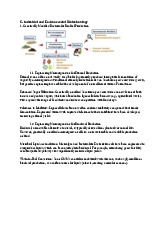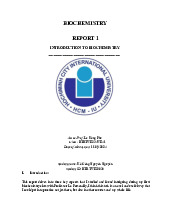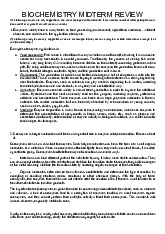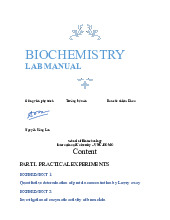



















Preview text:
lOMoAR cPSD| 59085392 SBT1102 - Biochemistry BTE/BME/BIN II Semester
SBT1102 – BIOCHEMISTRY UNIT 1 CARBOHYDRATES
Introduction. Classification, Properties and Biological importance. Isomers, epimers,
enantiomers,mutarotation, open chain and closed chain structures of glucose.
UNIT 2 AMINOACIDS AND PROTEINS
Aminoacids: classification- essential and non-essential amino acids, protein and
nonprotein amino acids, Zwitter ions. Proteins: Classification- based on i) shape and
solubility and i ) increasing complexity of structure. Structure of proteins: primary,
secondary, tertiary and quaternary, biological significance. Concept of isoelectric point and its significance. UNIT 3 LIPIDS
Introduction, Classification, Properties and Biological importance. Fatty acid
nomenclature and structure, Lipids in cel membrane Cholesterol and Steroids,
Hormones - structure and function UNIT 4 NUCLEIC ACIDS
Introduction- Nitrogeneous bases - Purines and Pyrimidines - Nucleosides and
Nucleotides -- Structure of nucleic acids - DNA, RNA: m-RNA, t-RNA, r-RNA -
Biological importance of nucleic acids. 16s rRNA and its significance. lOMoAR cPSD| 59085392 SBT1102 - Biochemistry BTE/BME/BIN II Semester
UNIT 5 VITAMINS AND MINERALS
Vitamins: fat soluble and water soluble vitamins. Minerals: Micro and Macro minerals.
Biological importance of vitamin and minerals, deficiency symptoms CARBOHYDRATES
Carbohydrates are the most abundant biomolecules on earth. Oxidation of
carbohydrates is the central energy-yielding pathway in most non-photosynthetic cel s.
Definition:Carbohydrates are polyhydroxy aldehydes or ketones, or substances that
yield such compounds on hydrolysis. carbohydrates have the empirical formula (CH2O)n.
There are three major classes of carbohydrates: 1. Monosaccharides
Monosaccharides, or simple sugars, consist of a single polyhydroxy aldehyde or
ketone unit. The most abundant monosaccharide in nature is the six-carbon sugar
Dglucose, sometimes referred to as dextrose. 2. Oligosaccharides
Oligosaccharides consist of short chains of monosaccharide units, or residues,
joined by characteristic linkages cal ed glycosidic bonds. The most abundant are the
disaccharides, with two monosaccharide units. Example: sucrose (cane sugar). 3. Polysaccharides
The polysaccharides are sugar polymers containing more than 20 or so
monosaccharide units, and some have hundreds or thousands of units. Example: starch.
Polysaccharides are of two types based on their function and composition. Based on
function, polysaccharides of two types storage and structural. A. Storage polysaccharide - starch. lOMoAR cPSD| 59085392 SBT1102 - Biochemistry BTE/BME/BIN II Semester
B. Structural polysaccharide - cel ulose.
General properties of carbohydrates •
Carbohydrates act as energy reserves, also stores fuels, and metabolic intermediates. •
Ribose and deoxyribose sugars forms the structural frame of the genetic material, RNA and DNA. •
Polysaccharides like cel ulose are the structural elements in the cell wal s of bacteria and plants. •
Carbohydrates are linked to proteins and lipids that play important roles in cel interactions. •
Carbohydrates are organic compounds, they are aldehydes or ketones with many hydroxyl groups.
Physical Properties of Carbohydrates •
Steroisomerism - Compound shaving same structural formula but they differ
in spatial configuration. Example: Glucose has two isomers with respect to
penultimate carbon atom. They are D-glucose and L-glucose. •
Optical Activity - It is the rotation of plane polarized light forming (+) glucose and (-) glucose. lOMoAR cPSD| 59085392 SBT1102 - Biochemistry BTE/BME/BIN II Semester •
Diastereoisomeers - It the configurational changes with regard to C2, C3, or
C4 in glucose. Example: Mannose, galactose. •
Annomerism - It is the spatial configuration with respect to the first carbon
atom in aldoses and second carbon atom in ketoses. Biological Importance •
Carbohydrates are chief energy source, in many animals, they are instant
source of energy. Glucose is broken down by glycolysis/ kreb's cycle to yield ATP. •
Glucose is the source of storage of energy. It is stored as glycogen in animals and starch in plants. •
Stored carbohydrates acts as energy source instead of proteins. •
Carbohydrates are intermediates in biosynthesis of fats and proteins. •
Carbohydrates aid in regulation of nerve tissue and is the energy source for brain. •
Carbohydrates gets associated with lipids and proteins to form surface
antigens, receptor molecules, vitamins and antibiotics. •
They form structural and protective components, like in cel wal of plants and microorganisms. •
In animals they are important constituent of connective tissues. •
They participate in biological transport, cel -cel communication and activation of growth factors. •
Carbohydrates that are rich in fibre content help to prevent constipation. •
Also they help in modulation of immune system. Monosaccharides •
The word “Monosaccharides” derived from the Greek word “Mono” means
Single and “saccharide” means sugar •
Monosaccharides are polyhydroxy aldehydes or ketones which cannot be
further hydrolysed to simple sugar. •
Monosaccharides are simple sugars. They are sweet in taste. They are soluble
in water. They are crystal ine in nature. lOMoAR cPSD| 59085392 SBT1102 - Biochemistry BTE/BME/BIN II Semester •
They contain 3 to 10 carbon atoms, 2 or more hydroxyl (OH) groups and one
aldehyde (CHO) or one ketone (CO) group.
Classification of Monosaccharides
Monosaccharides are classified in two ways. (a) First of al , based on the
number of carbon atoms present in them and (b) secondly based on the presence of carbonyl group.
The naturally occurring monosaccharides contain three to seven carbon
atoms per molecule. Monosaccharides of specific sizes may be indicated by names
composed of a stem denoting the number of carbon atoms and the suffix -ose. For
example, the terms triose, tetrose, pentose, andhexose signify monosaccharides
with, respectively, three, four, five, and six carbon atoms. Monosaccharides are also
classified as aldoses or ketoses. Those monosaccharides that contain an aldehyde
functional group are called aldoses; those containing a ketone functional group on
the second carbon atom are ketoses. Combining these classification systems gives
general names that indicate both the type of carbonyl group and the number of
carbon atoms in a molecule. Thus, monosaccharides are described as aldotetroses,
aldopentoses, ketopentoses, ketoheptoses, and so forth. Glucose and fructose are
specific examples of an aldohexose and a ketohexose, respectively. lOMoAR cPSD| 59085392 SBT1102 - Biochemistry BTE/BME/BIN II Semester Trioses
Trioses are “Monosaccharides” containing 3 carbon atoms. The molecular formula of triose is C3H6O3 Characteristics • Trioses are simple sugars • They are soluble in water • They are sweet in taste.
• The triose may contain an aldehyde group (aldotriose) or a ketone group
(ketotriose). Example Glycerose and Dehydroxyacetone Tetroses
Tetroses are “Monosaccharides” containing 4 carbon atoms. The molecular formula of tetrose is C4H8O4 lOMoAR cPSD| 59085392 SBT1102 - Biochemistry BTE/BME/BIN II Semester Characteristics lOMoAR cPSD| 59085392 SBT1102 - Biochemistry BTE/BME/BIN II Semester
• Tetroses are simple sugars • Tetroses are soluble in water • They are sweet in taste.
• They are crystal ine forms.
• The tetroses may contain an aldehyde group (aldotetrose) or a ketone group (ketotetrose). Erythrose Pentoses
Pentoses are “Monosaccharides” containing 5 carbon atoms. It is an important
component of “nucleic acid”. The molecular formula of Pentose is C5H10O5 Characteristics
• Pentoses are simple sugars • Pentoses are soluble in water • They are sweet in taste.
• They are crystal ine forms.
• The pentoses may contain an aldehyde group (aldopentose) or a ketone group (ketopentose). lOMoAR cPSD| 59085392 SBT1102 - Biochemistry BTE/BME/BIN II Semester Hexoses
Hexoses are “Monosaccharides” containing 6 carbon atoms. The molecular formula of Hexose is C6H12O6 Characteristics
• Hexoses are simple sugars • Hexoses are soluble in water • They are sweet in taste.
• They are crystal ine forms.
• The pentoses may contain an aldehyde group (aldohexose) or a ketone group (ketohexose).
Structure of Monosaccharides
1. Straight or Open Chain Structure: Here 6 carbon atoms of glucose are
arranged in a straight line. It is also cal ed open chain structure because the two
ends remain separate and they are not linked. Open chain structure are of two types –
• (a)Structure proposed by Fittig and Baeyer
• (b)Structure proposed by Fischer known as Fischer’s Projection Formula. lOMoAR cPSD| 59085392 SBT1102 - Biochemistry BTE/BME/BIN II Semester
2. Cyclic or Ring Structure: Here the atoms are arranged in the form of a ring.
Haworth (1929) proposed this formula and hence the name Haworth’s Projection
Formula. The sugar molecules exist in two type of rings which are as follows –
(a)Furanose Ring – 5 membered ring
(b)Pyranose Ring- 6 membered ring
Properties of Monosaccharides 1.Colour - colourless 2.Shape - crystal ine
3.Solubility – water soluble lOMoAR cPSD| 59085392 SBT1102 - Biochemistry BTE/BME/BIN II Semester 4.Taste - sweet lOMoAR cPSD| 59085392 SBT1102 - Biochemistry BTE/BME/BIN II Semester
5.Optical activity – Optical y active. (a) Dextrorotatory (‘d’ form) and (b) Levorotatory (‘l’ form)
6.Mutarotation – The change in specific rotation of an optically active compound is
cal ed mutarotation. +1120 +52.50 +190 α-D-glucose β -D-glucose 7. Glucoside formation -
Glucose + Methyl alcohol = Methyl glucoside 8. Esterification – lOMoAR cPSD| 59085392 SBT1102 - Biochemistry BTE/BME/BIN II Semester
9. Reducing agents –
Monosaccharides reduce oxidizing agent such as hydrogen peroxide. In such
reaction, sugar is oxidized at the carbonyl group and oxidizing agent becomes reduced.
C6H12O6 + 2 Cu(OH)2→C6H12O7 + Cu2O + 2H2O Glucose Fehling’s GluconicCuprous solutionacid oxide
10. Formation of Osazone – Disaccharides
Disaccharides consist of two sugars joined by an O-glycosidic bond.
The most abundant disaccharides are sucrose,lactose and maltose.
Other disaccharides include isomaltose, cel obiose and trehalose.
The disaccharides can be classified into: lOMoAR cPSD| 59085392 SBT1102 - Biochemistry BTE/BME/BIN II Semester
1. Homodisaccharides
2. Heterodisaccharides. Hommodisaccharides Isomaltose Celebiose Maltose (malt sugar ) structure 2α-glucose 2 α-glucose 2β-D-glucose Type of bond α-1-4 α1-6 β1-4 glucosidicbond glucosidicbond glucosidicbond. Anomeric Carbon Free Free Free Reducing Property Reducing Reducing Reducing Produced by
It is produced by the hydrolysis of by the acid from starch by the some hydrolysis of
action of amylase polysaccharides cel ulose such as dextran
Heterodisaccharides: are formed of 2 different monosaccharide units
Heterodisaccharides Sucrose Lactose Composition α-D-glucose+ β–D-fructose β-D-galactoseand β- Dglucose lOMoAR cPSD| 59085392 SBT1102 - Biochemistry BTE/BME/BIN II Semester Type of bond α-1-β-2 glucosidic bond OR a β (1 4) β 2-α-1 fructosidic bond galactosidicbond AnomericC no free aldehydeor free ketonegroup Reducing property is not a reducing sugar Reducing Composition
α-D-glucose+β–D-fructose β-D-galactoseandβ- Dglucose AnomericC
nofreealdehydeorketonegroup free Effectofhydrolysis The hydrolysis of sucrose to Hydrolysed by the glucose and fructose is intestinal lactase catalysed by sucrose (also enzyme into galactose cal ed invertase), and glucose Present in Table sugar Milk sugar Cane sugar, It may appear in urine in beet sugar late pregnancy and during lactation lOMoAR cPSD| 59085392 SBT1102 - Biochemistry BTE/BME/BIN II Semester Polysaccharides
Polysaccharides contain hundreds or thousands of carbohydrate units. •
Polysaccharides are not reducing sugars, since the anomeric carbons are
connected through glycosidic linkages. • Nomenclature:
Homopolysaccharide- a polysaccharide is made up of one type of monosaccharide unit
Heteropolysaccharide- a polysaccharide is made up of more than one type of monosaccharide unit Starch •
Starch is a polymer consisting of D-glucose units. lOMoAR cPSD| 59085392 SBT1102 - Biochemistry BTE/BME/BIN II Semester •
Starches (and other glucose polymers) are usual y insoluble in water because
of the high molecular weight, but they can form thick col oidal suspensions with water. •
Starch is a storage compound in plants, and made of glucose units •
It is a homopolysaccharide made up of two components: amylose and amylopectin. •
Most starch is 10-30% amylose and 70-90% amylopectin. •
Amylose – a straight chain structure formed by 1,4 glycosidic bonds
between α-D-glucose molecules. C H 6 CH CH 2 O H C H 2 O H CH 2OH 2 OH OH 2 H O 5 O H H H H O H H O H H H H O H H H H OH H 1 4 OH H 1 OH OH O H H O O H O H O OH OH 3 2 H OH H OH H OH H H OH OH amylose
Structure of Amylose Fraction of Starch •
The amylose chain forms a helix. •
This causes the blue colour change on reaction with iodine. •
Amylose is poorly soluble in water, but forms micel ar suspensions •
Amylopectin-a glucose polymer with mainly α -(1→4) linkages, but it also has
branches formed by α -(1→6) linkages. Branches are generally longer than shown above. CH 2OH CH 2OH H O amylopectin H HH O H H OH H OH H O 1 O H O H OH H OH CH 2OH CH 2 OH 6C H 2 CH CH 2 OH OH 2 H O HH H 5 O H O H H H OH H H H H O H H 1 4 OH H OH H OH 4 OH OH H O H O O H O O H OH 3 2 H O H H O H H OH H OH H OH
Structure of Amylopectin Fraction of Starch
• Amylopectin causes a red-violet colour change on reaction with iodine.
• This change is usual y masked by the much darker reaction of amylose to iodine. lOMoAR cPSD| 59085392 SBT1102 - Biochemistry BTE/BME/BIN II Semester Glycogen
• Storage polysaccharide in animals
• Glycogen constitutes up to 10% of liver mass and 1-2% of muscle mass
• Glycogen is stored energy for the organism
• Similar in structure to amylopectin, only difference from starch: number of branches
• Alpha(1,6) branches every 8-12 residues
• Like amylopectin, glycogen gives a red-violet color with iodine Cellulose
• The β-glucose molecules are joined by condensation, i.e. the removal of water,
forming β-(1,4) glycosidic linkages.
• The glucose units are linked into straight chains each 100-1000 units long.
• Weak hydrogen bonds form between paral el chains binding them into cel ulose microfibrils.
• Cel ulose microfibrils arrange themselves into thicker bundles cal ed
microfibrils. (These are usual y referred to as fibres.) lOMoAR cPSD| 59085392 SBT1102 - Biochemistry BTE/BME/BIN II Semester
• The cel ulose fibres are often “glued” together by other compounds such as
hemicelluloses and calcium pectate to form complex structures such as plant cel walls.
• Because of the β-linkages, cel ulose has a different overal shape from
amylose, forming extended straight chains which hydrogen bond to each other,
resulting in a very rigid structure.
• Cel ulose is an important structural polysaccharide, and is the single most
abundant organic compound on earth. It is the material in plant cel wal s that
provides strength and rigidity; wood is 50% cel ulose.
• Most animals lack the enzymes needed to digest cel ulose, although it does
provide needed roughage (dietary fiber) to stimulate contraction of the
intestines and thus help pass food along through the digestive system
• Some animals, such as cows, sheep, and horses, can process cellulose
through the use of colonies of bacteria in the digestive system which are
capable of breaking cel ulose down to glucose; ruminants use a series of
stomachs to al ow cel ulose a longer time to digest. Some other animals such
as rabbits reprocess digested food to al ow more time for the breakdown of cel ulose to occur.
• Cel ulose is also important industrial y, from its presence in wood, paper,
cotton, cel ophane, rayon, linen, nitrocellulose (guncotton), photographic films (cel ulose acetate), etc. CHITIN
• Chitin is a polymer that can be found in anything from the shel s of beetlesto
webs of spiders. It is present al around us, in plant and animal creatures.
• It is sometimes considered to be a spinoff of cel ulose, because the two are very molecularly similar. lOMoAR cPSD| 59085392 SBT1102 - Biochemistry BTE/BME/BIN II Semester
• Cel ulose contains a hydroxy group, and chitin contains acetamide.
• Chitin is unusual because it is a "natural polymer," or a combination of
elements that exists natural y on earth.
• Usual y, polymers are man-made. Crabs, beetles, worms and mushrooms
contain large amount of chitin.
• Chitin is a very firm material, and it help protect an insect against harm and pressure



